If you’re interested in making the most of your limited garden space, vertical gardening may just be the gardening hack you’re looking for. Not only does this innovative approach let you grow more in less square footage, but it also can lead to a healthier and more abundant crop of your favorite edibles. For those eager to delve into this method, understanding which best vegetables for vertical gardening to select is crucial. In your quest to maximize your garden’s productivity and aesthetic appeal, we’ll introduce you to some of the most successful vertical gardening vegetables that surely won’t disappoint your green thumb or your taste buds.
Whether you’re an urban gardener with a petite patio or a suburban dweller looking to jazz up your garden, these carefully selected vertical gardening champions are designed to thrive upward. From the prolific vining tomatoes to the spirited climbing peas, every recommended plant is chosen for its propensity to grow vertically. Let’s scale new heights together and turn your garden into an upward oasis of verdant vitality!
Key Takeaways
- Discovering vertical gardening vegetables tailored for upward growth to enhance your garden space.
- Embracing best vegetables for vertical gardening for optimized yield and space efficiency.
- Maximizing your garden’s potential with successful vertical gardening vegetables like vining tomatoes and climbing peas.
- Learning to select vegetables that are suited to vertical cultivation and easy to maintain and harvest.
- Gleaning insights on how vertical gardening can lead to a healthier and more bountiful vegetable harvest.
Growing Up: Unveiling the Magic of Vertical Gardening
The concept of vertical gardening is not just a trend; it’s a pragmatic solution for urban dwellers seeking to maximize their green space. When your real estate is limited but your passion for fresh, homegrown produce is infinite, employing vertical gardening tips for veggies can lead to a lush and productive green wall. Understanding the art of growing optimal vegetables for a vertical garden is key to reaping the bountiful harvest that this innovative farming technique can offer.
The Space-Efficient Revolution in Urban Gardening
As cities grow denser, gardeners across the United States are elevating their game—quite literally. By utilizing fences, trellises, and sturdy vertical supports, plants such as tomatoes, peas, and cucumbers are trained to reach for the skies. This space-efficient method not only creates a vibrant, living tapestry but also opens up a plethora of previously unusable spaces to the wonders of horticulture.
The Physical Ease of Vertical Harvesting
One of the greatest advantages you’ll notice with vertical gardening is the reduction in physical strain during maintenance and harvest. Forget about the endless hours of crouching and tending to ground-level vegetables. Your vertical veggie garden brings the fruits of your labor up to a more accessible height, simplifying everything from pruning to picking.
Enhanced Plant Health and Yield
Plant health is paramount for a bountiful garden, and vertical gardens are known to facilitate better air circulation and exposure to sunlight. This means quicker drying leaves and fewer issues with fungal diseases, key elements that contribute to an overall increase in the health and yield of your vegetables. Pay special attention to your watering routines, as these new heights can also lead to faster soil drying, especially for your wall-mounted edible treasures.
Embrace these tips and watch as your vertical garden transforms into an abundant tower of delectable veggies, combining style with substance in the urban jungle.
Understanding Vertical Gardening Structures
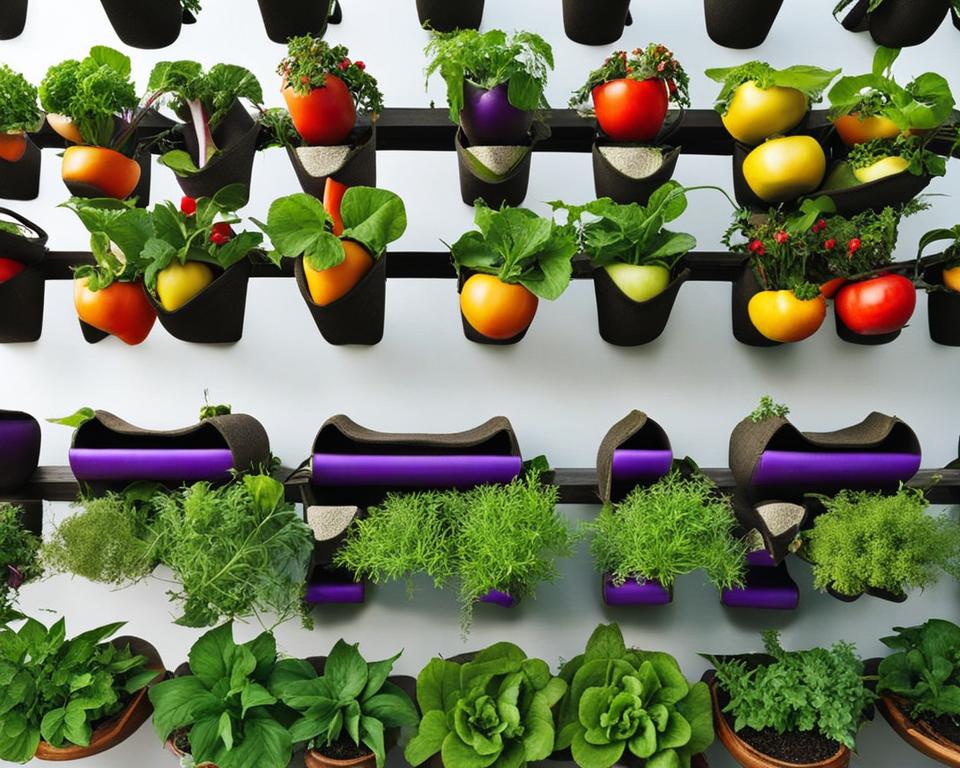
Embarking on the journey of vertical gardening brings with it the necessity of understanding the skeletal framework that will support your bountiful harvests. Selecting the appropriate vertical gardening structures not only maximizes your space but also ensures the well-being of your chosen crops.
Best Support Types for Your Climbers
The diverse array of structural options includes everything from wooden trellises to metal arches, each with its own set of benefits. Your vertical gardening vegetable selection might include climbers like cucumbers and pole beans, which flourish on structures that allow their tendrils to grip and ascend. Here, the lightweight yet sturdy materials of netting or string trellises come into play.
On the other hand, for heavier fruit-bearers like squashes, a more robust setup is required. Strong wooden or metal arches will give these vigorous plants the foundation they need to thrive without buckling under the weight of their yield.
Matching Plants with the Strength of Structures
It is imperative that you match the vigor and mature weight of your plants to the strength of their supports. Delicate climbers can make do with slender stakes, while dense fruit trees or heavyweight grapevines will need something much more substantial. For example, a robust pergola serves as an excellent anchor for the profuse growth of a grapevine. Consideration of types of vertical gardening structures is not complete without taking into account the need for stability to prevent toppling and ensure long-term success. Free-standing wire supports provide an ideal solution for fruit trees, granting them a vertical plane to grow against as they mature.
- Trellises – Perfect for beans, peas, and vining tomatoes
- Wire cages – Suitable for tomatoes and small-fruited varieties of squash
- Gazebos and arches – Ideal supports for grapevines and other hearty plants
- Bamboo poles – Best for lightweight climbers such as sweet peas
By aligning your vegetable selection with structurally sound and appropriate garden architecture, your vertical garden will flourish, producing an abundant and visually appealing harvest.
Top Vegetables for Vertical Garden and Their Varieties
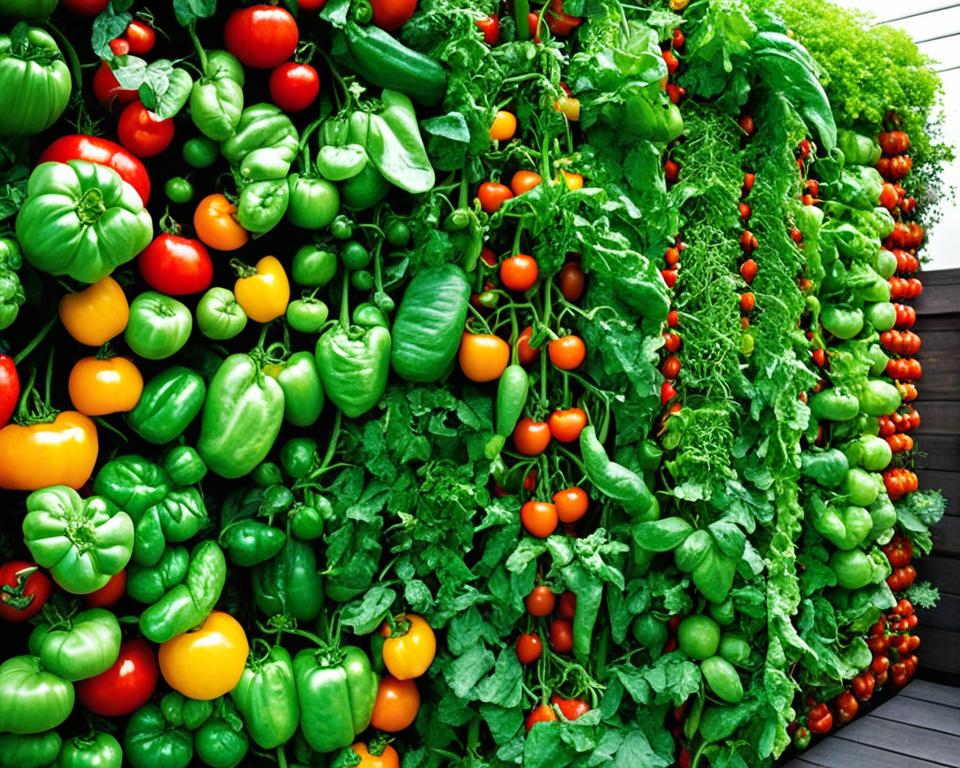
When considering top vegetables for vertical garden setups, certain varieties stand out for their robust growth and ease of management. Vertical gardens not only offer a novel approach to urban agriculture but also provide an efficient utilization of space, creating an opportunity to grow a productive garden almost anywhere. Now let’s explore some prime candidates for your vertical gardening endeavors.
Pole Beans for Your Pergolas and Trellises
Pole beans are a staple in the vertical gardening community. With vines that eagerly climb supports, they are not only productive vegetables for vertical gardening but also add a lush greenery to your pergola and trellis structures. A favorite among poles beans is the ‘Romano Italian’, known for its flavorful and tender pods. Another variety that thrives vertically is the ‘Meraviglia Venezia’, which offers abundant and delicious harvests throughout the season.
Beyond these, don’t overlook other climbing beans such as the Blue Lake and Kentucky Wonder, which are equally adept at upward growth. Remember, providing a stable structure for these climbers will ensure maximum yield and easier harvesting.
Cucumbers: From Compact to Climbing Varieties
Cucumbers are another group of vegetables that adapt well to vertical gardens. Varieties such as ‘Burpee Hybrid II’ and ‘County Fair 83’ are bred for disease resistance and production, making them optimal choices for growing upwards. The key to cucumber success lies in choosing the right variety; some are made for pickling, while others are perfect for fresh salads.
Compact bush types are suitable if your vertical space is limited, but for a true vertical experience, opt for vining cucumbers that will climb with vigor. These varieties will take full advantage of the vertical space by spanning trellises and other supports with their trailing vines.
Here’s a comparative look at some popular varieties to assist you in making an informed decision:
| Vegetable Type | Variety | Growth Habit | Expected Harvest Size |
|---|---|---|---|
| Pole Beans | Romano Italian | Climbing | Large, Tender Pods |
| Pole Beans | Meraviglia Venezia | Climbing | Plentiful Harvest |
| Cucumbers | Burpee Hybrid II | Climbing/Trailing | Sizable, Resistant to Pests |
| Cucumbers | County Fair 83 | Climbing/Trailing | Consistent Yields |
Aspiring vertical gardeners, bear these selections in mind as they not only enhance your garden’s aesthetics but also yield a bounty of fresh vegetables throughout the growing season. Feel free to experiment with various structures and discover the climbing capabilities of these verdant marvels. Happy gardening!
Optimizing Sunlight in Vertical Vegetable Gardens
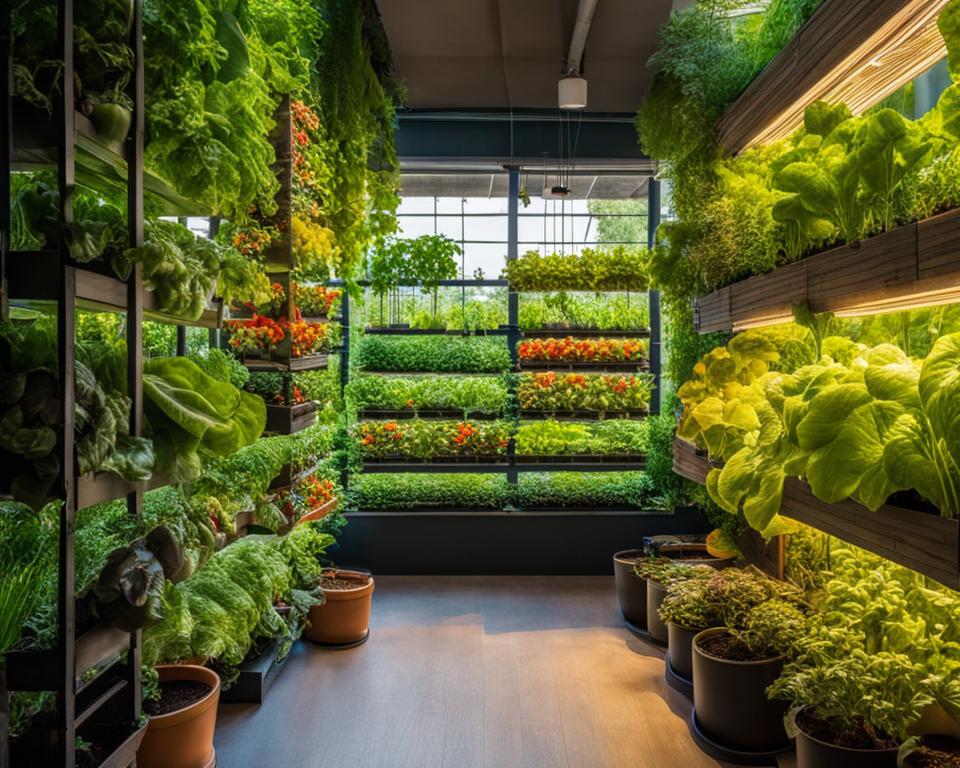
As you venture into the realm of vertical gardening, understanding the importance of sunlight is crucial for your vertical vegetable garden plants. Not only does the amount of sunlight affect growth and yield, but so does the way your garden is oriented in relation to the sun’s path. Let’s explore the best strategies for directional positioning and heat absorption to ensure your best crops for vertical gardening thrive.
Directional Positioning for Maximal Light Exposure
To maximize the vertical garden’s sunlight exposure, consider the journey of the sun across the sky. Ideally, your vertical garden should face south to bask in the midday and afternoon sun when it’s at its strongest. This ensures your garden receives a robust 6 to 8 hours of sunlight, essential for the health and productivity of your produce. Remember, some crops may have specific light requirements, so plan the arrangement of your vertical vegetable garden plants accordingly.
Heat Absorption for Faster Growth
The materials of your vertical structures can assist in extending daylight warmth into the night. Materials like wood or stone absorb heat and then slowly release it, providing your plants with a snug and warm environment even after dusk. This not only accelerates growth but can also lead to an earlier harvest. Vining vegetables, in particular, benefit from this heat retention, making them some of the best crops for vertical gardening.
DIY Tips: Building Your Own Vertical Gardening Structures
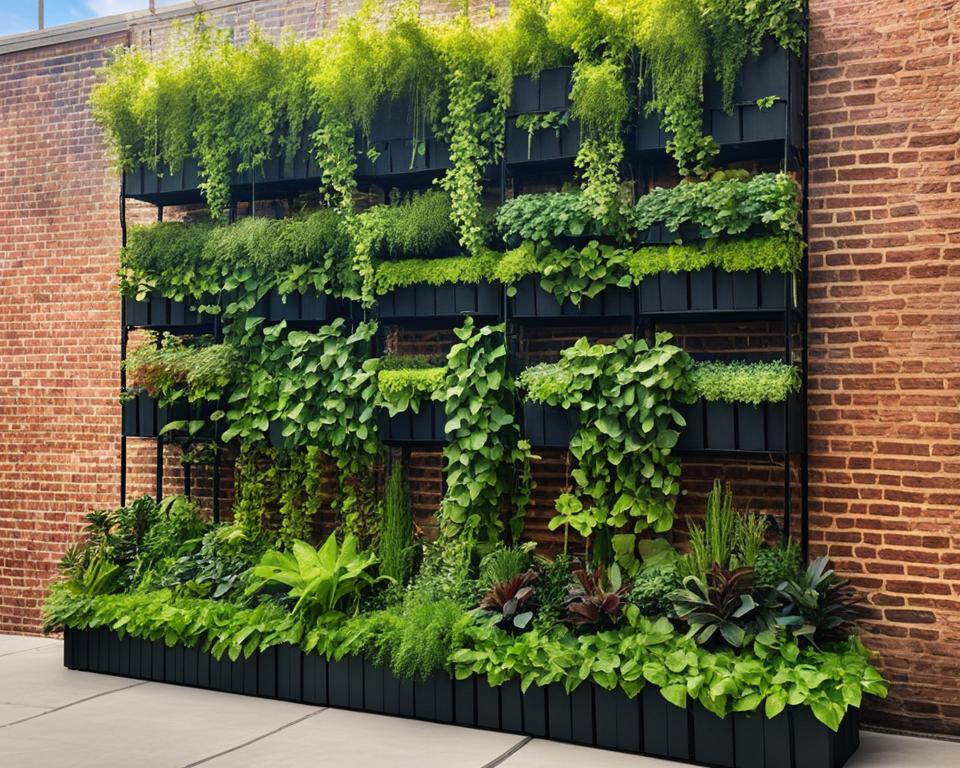
Embracing vertical gardening comes with a spectrum of benefits, but perhaps one of the most satisfying is the ability to create personalized structures that perfectly fit your space and gardening goals. Whether you’re hoping to grow a lush wall of vertical gardening vegetables or looking for vertical gardening tips for veggies, DIY projects are an affordable and fulfilling way to make the most out of your garden.
Starting with a living wall, you can choose a sun-facing wall on your property and attach a trellis or grid that will serve as the foundation. Utilizing pots or planters, you can cultivate a variety of herbs, leafy greens, and small vegetables. This setup not only allows you to save space but also adds to the aesthetic appeal of your outdoor area.
For those who enjoy the architectural elements of gardening, constructing a vegetable arch could be an ideal project. By shaping metal or wooden supports into an arch and securing them into the ground, you create a sturdy structure upon which your veggies can climb. This not only becomes a focal point in your garden but also supports the growth of vegetables like beans and vine tomatoes.
- Bean Teepees: For a fun and functional addition, gather long bamboo poles or sturdy branches and tie them together at the top to form a teepee. Wrap around some garden twine or netting to give your climbing beans and peas something to hold onto as they grow.
- Pallet Planters: An upcycled wooden pallet can be transformed into a vertical planter by sealing the backside, adding a bottom, and filling it with soil. Great for lettuce, spinach, and herbs, this option provides a rustic touch and is perfect for gardeners working with limited space.
Each of these options can be adapted to the specific needs of your plants and space, ensuring a thriving and productive vertical garden. Remember to secure all structures well and to choose plants that suit your climate and sunlight availability to reap the best harvest.
As you embark on these DIY vertical gardening projects, you invite not only an array of vegetables into your urban or backyard garden but also a dose of creativity and customization. It’s a wonderful way to merge functionality with aesthetic charm, giving rise to garden spaces that nourish both the body and the spirit.
Best Vegetables for Vertical Gardening: A Curated List
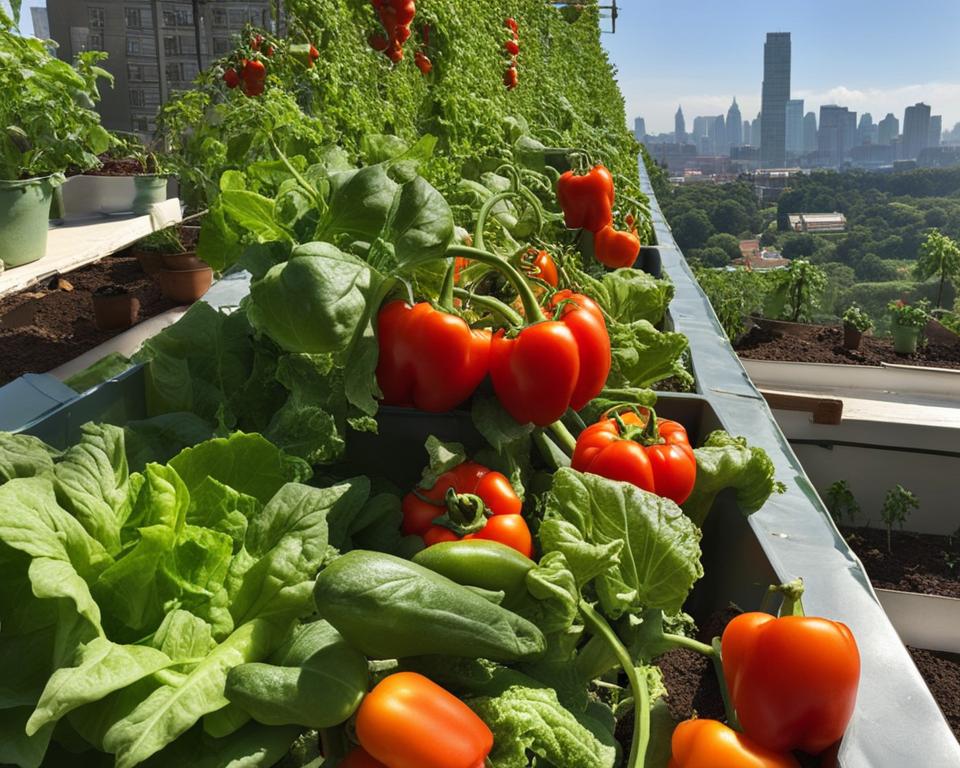
Aspiring to create a lush and bountiful vertical garden? Focusing on successful vertical gardening vegetables can transform your vertical space into a thriving green oasis. The best vegetables for vertical gardening not only maximize your growing area but also minimize the effort needed for maintenance and harvesting. Below is a carefully curated list of the top performers in vertical gardening that promise to bring you success and abundance.
| Vegetable | Description | Benefits |
|---|---|---|
| Pole Beans | Vining variety, often producing over a long season | Simple to train up supports, high yield, easy harvesting |
| Cucumbers | Fast-growing, trailing plants that flourish with vertical room | Space-saving, enhances airflow, decreases disease susceptibility |
| Sweet Potatoes | Decorative vines that can grow vertically with support | Keeps vines off the ground, prevents pest damage |
| Specific Melons | Selected smaller types suitable for vertical growth | Support with nets to grow vertically, saves ground space |
| Squash (e.g., Acorn, Delicata) | Varieties that can be trained to grow upwards | Prevents rot, reduces pest interactions, easy to monitor growth |
| Climbing Tomatoes | Indeterminate varieties that grow and produce throughout the season | Maximizes sun exposure, increases airflow, eases harvest |
When selecting best vegetables for vertical gardening, choose those that naturally climb or can be easily supported. This approach not only enhances the visual appeal of your garden but also ensures a fruitful and rewarding gardening experience, making your vertical garden both productive and picturesque.
Embrace the vertical dimension in your garden by incorporating these vegetables, and watch as it flourishes into an impressive and flourishing display of verdure and bounty.
Vertical Gardening Tips for Veggies: Watering and Feeding
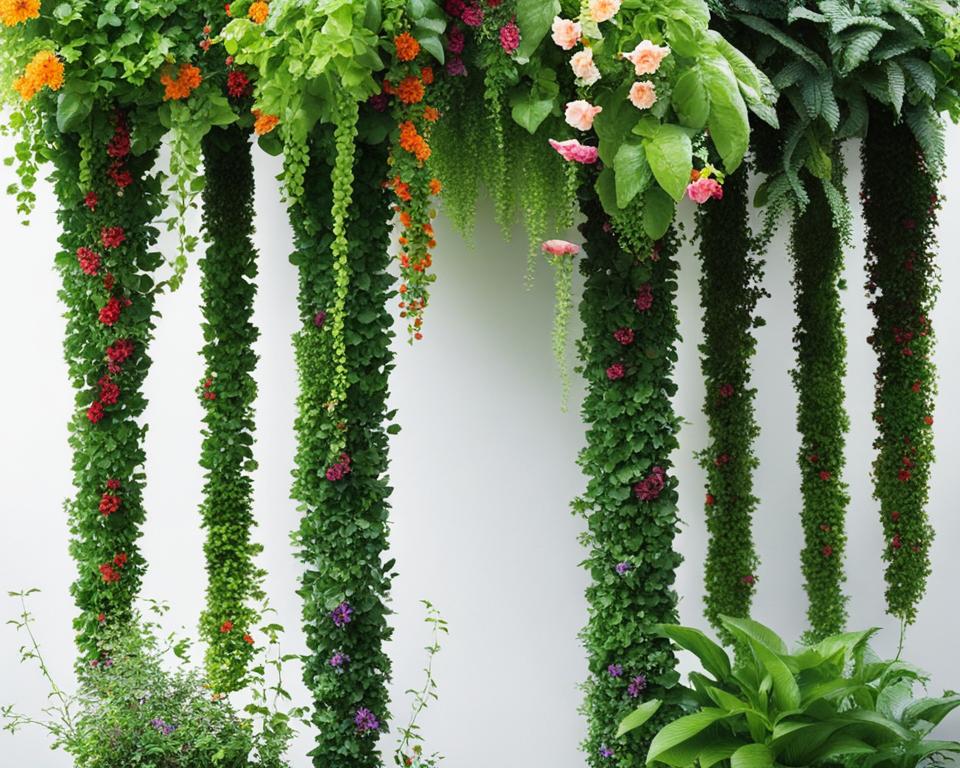
Mastering the art of watering and feeding is essential for the health of your vertical gardening vegetable selection. Due to the vertical structure’s exposure to the elements, it’s not uncommon to find your soil drying out faster than in traditional garden beds. This can be especially challenging when striving to grow productive vegetables for vertical gardening. But don’t worry, a few smart strategies can ensure your garden remains hydrated and well-nourished.
Efficient Watering Techniques for Vertical Gardens
Implementing a micro or drip irrigation system is a game-changer for vertical gardens. It streamlines the watering process, delivering moisture directly to the root zone of each plant. You can automate this system with a timer, ensuring that your garden is consistently watered, even when you’re away. Not only does this save water, but it also promotes deep root growth and plant health — two crucial elements for a thriving vertical garden.
Nutrient Management for Elevated Plant Beds
Just as your vertical garden demands regular watering, it equally requires careful nutrient management. Elevating your vegetable selection brings about unique nutrient needs. To address this, consider using a well-balanced, water-soluble fertilizer that you can apply during your irrigation cycle. This ensures that your plants get the vital nutrients they need without you having to remember additional fertilizing schedules.
| Vegetable | Watering Needs | Fertilization Tips |
|---|---|---|
| Radishes | Moderate, consistent moisture | Light feeding; high in phosphorus for root development |
| Carrots | Regular watering to avoid root splitting | Use potassium-rich fertilizer for robust growth |
| Beets | Keep soil evenly moist, not waterlogged | Low nitrogen; fertilize for sweet and tender roots |
| Leafy Greens | Consistent watering to prevent wilt | Periodic feeding with balanced N-P-K ratio |
Adopting these watering and feeding practices will lead you toward a bountiful harvest. And remember, the key to productive vegetables for vertical gardening is consistency. With the right care, your vertical gardening vegetable selection will not only thrive but also become a highlight of your urban garden.
Productive Vegetables for Vertical Gardening and Their Growth Habits
As you explore the optimal vegetables for vertical garden setups, it’s important to consider the natural growth habits of your plant selections. Plants that entwine or have tendrils, like pole beans and peas, naturally reach for the light and can be effectively directed to grow up along trellises and nettings. These are known as some of the top vegetables for vertical garden use due to their adaptability and upward growth.
Other popular choices include vegetables that bear fruit from trailing vines. For example, watermelons require sturdier support systems like strong nets or trellises to manage their weight as they grow. By providing these conditions, you can encourage productive vertical growth even in compact spaces.
- Cruciferous vegetables like kale and brussels sprouts
- Nightshade family members such as tomatoes and peppers
Both of these groups have members that can be adapted for vertical growth. Tomatoes, in particular, can thrive when supported by cages or stakes that accommodate their climbing tendency and support their weight. The choice of indeterminate tomato varieties can be especially rewarding as they continue to grow and produce fruit throughout the season.
When arranging your garden, pay special attention to the weight of the plants and ensure their supports are sufficient to hold them aloft. This preventative step will save you time and ensure the health and productivity of your garden.
Vertical Gardening Vegetable Selection: What to Grow for Success
Embarking on your vertical gardening adventure calls for strategic choices, not just about the structures you use but also the vegetables you plant. As space is at a premium, selecting the right type of crops can make all the difference in cultivating a bountiful, thriving garden.
Making the Right Choice: Vining vs. Bush-Type Vegetables
For those keen on the best crops for vertical gardening, vining vegetables are your go-to allies. Their natural inclination to climb makes them ideal for training up trellises and other vertical supports. This choice doesn’t just save valuable ground space but also leads to better light exposure and air circulation, promoting healthier growth and easing the harvesting process. On the flip side, bush-type varieties may be less suitable because they tend to spread outwards, consuming more space at ground level.
Seasonal Considerations for Vertical Planting
Seasonality plays a pivotal role in your garden’s success. For example, warm-season vegetables such as tomatoes and sweet potatoes flourish when they’re planted at the right time. These successful vertical gardening vegetables need ample sunlight and warmth to thrive, so it’s crucial to understand the seasonal patterns of your region and choose your planting schedule accordingly.
Below is a table for you to refer to when deciding which vegetables are best suited for your vertical garden:
| Vegetable Type | Season | Reason for Suitability |
|---|---|---|
| Pole Beans | Warm-season | Climbing habit; requires minimal horizontal space |
| Climbing Peas | Cool-season | Cool-weather tolerant; can climb with minimal support |
| Indeterminate Tomatoes | Warm-season | Continuous growth and yield; ideal for trellises |
| Cucumbers | Warm-season | Vining variety can easily be trained upwards |
| Sweet Potatoes | Warm-season | Vigorous climbers; leaves are ornamental |
Remember, the success of these plants will also depend on proper care, including appropriate watering and nutrient management. With the right selection and care, your vertical garden will not only be a sight to behold but a testament to your green thumb.
Champion Climbers: Sweet Potatoes and Tomatoes
As you delve into the world of vertical gardening vegetable selection, two plants stand out for their climbing abilities and the benefits they bring to your vertical vegetable garden plants: sweet potatoes and tomatoes. These champions thrive when vertically oriented, encouraging a fruitful and space-saving harvest. Here’s a detailed look at their vertical gardening virtues.
Sweet potatoes are not only nutritious but also aesthetically pleasant as they ornate your garden with verdant vines. When allowed to climb a structure, they not only save you precious garden space but also create a living curtain of foliage. Meanwhile, tomatoes, especially indeterminate varieties, are prolific producers when grown vertically. They benefit greatly from the additional air circulation and sunlight exposure that vertical arrangements provide.
Training sweet potatoes and tomatoes to grow upwards can significantly reduce the risk of soil-borne diseases and simplifies harvesting, making your gardening efforts more enjoyable and less labor-intensive.
Understanding the particular needs of these plants will ensure your garden is both lush and productive. Here’s a comparative overview to assist in your selection:
| Characteristic | Sweet Potatoes | Tomatoes |
|---|---|---|
| Plant Type | Vining tuber | Indeterminate climber |
| Support Structure | Trellises or vertical garden shelves | Stakes, cages, or trellises |
| Light Requirements | Full sun | Full sun |
| Soil Type | Well-drained, fertile | Rich, well-draining |
| Watering Needs | Regular, allowing for drying between waterings | Consistent moisture, avoiding foliage |
| Harvest Time | After foliage yellows and dies back | When fruit reaches full color and firmness |
| Space Saving | Excellent for compact spaces | Maximizes use of vertical space |
By choosing sweet potatoes and tomatoes for your vertical garden, you can expect a garden that’s not only high-yielding but also visually striking. Remember to select the right variety, provide sturdy support, and maintain consistent care to enjoy the beauty and bounty of these climbing vegetables.
Integrating Aesthetic Appeal with Productivity
Imagine stepping into your garden and being greeted by not only the promise of fresh produce but also by a breathtaking living art installation. This is the dual promise of vertical gardening vegetables—a harmonious blend of function and form. It’s where the best vegetables for vertical gardening also serve as the focal point of your outdoor décor, offering both sustenance and visual satisfaction.
Edible Landscaping with Vertical Vegetables
As you consider the layout of your vertical garden, think about how the natural textures and colors of the vegetables can accentuate the overall aesthetics of your space. With plants like vibrant cherry tomatoes or lush green beans, you bring a palette of nature’s colors to your patio or deck. Whether framing a sunny entranceway or adding privacy to an urban balcony, these living towers of best vegetables for vertical gardening merge practicality with pastoral beauty.
Creating Visually Pleasing Vegetable Displays
An artistically arranged vertical garden can be both a visual treat and a culinary boon. When designing your vertical structures, think of them as the canvas for your vegetable variety. Here’s a guide to composing a stunning yet productive vertical vegetable display:
| Vegetable | Type of Structure | Visual Benefit | Productivity Benefit |
|---|---|---|---|
| Cucumbers | Trellis or Netting | Lush, leafy greens with dangling fruit | Space-saving; eases harvesting |
| Peas | Bamboo poles or Chicken wire | Fine textured foliage with delicate flowers | Promotes air circulation and healthy growth |
| Decorative Peppers | Metal Grids or Vertical Pots | Bright pops of red, yellow, and purple | Accessible at eye-level for easy picking |
| Herbs (Mint, Basil) | Vertical Pallet Planters | Aromatic green layers with various textures | Keeps herbs tidy and prolific |
By selecting the proper plants and structures, you create a vertical garden that’s not just a vegetable patch, but a living sculpture. As an added benefit, your vertical garden becomes a topic of conversation, awakening the curiosity and appetites of your visitors. Who knew that the humble act of growing your food could also become the hallmark of your home’s landscaping charm?
Special Considerations for Fruit-Bearing Vertical Vegetables
Growing fruit-bearing vegetables such as melons, pumpkins, and squash vertically can significantly increase the efficiency of your garden space while boosting productivity. However, when it comes to productive vegetables for vertical gardening, these heavier fruits require robust support systems. Not only do sound structures help manage the weight of the fruit, but they also prevent any potential spoilage due to ground contact, ensuring you reap the best quality harvest from your top vegetables for vertical garden.
Supports Tailored for Larger Fruits: Unlike lightweight climbers, larger fruits like melons and squash will need supports such as reinforced trellises or cages that can accommodate the additional weight. Consider using materials such as thick wood, metal frames, or high-tensile wires. Let’s explore what your vertical garden might need for these plants to thrive.
| Vegetable | Type of Support | Benefits |
|---|---|---|
| Melons | Vertical netting or slings | Keeps fruit off the ground, reducing rot and pests |
| Pumpkins | Sturdy trellises or A-frames | Supports heavy fruit and promotes air circulation |
| Winter Squash | Strong wire cages or hammocks | Minimizes ground contact and encourages straighter growth |
Building the right infrastructure for your fruit-bearing vertical vegetables will not only enhance the visual appeal of your garden but will also maximize your garden’s yield. When constructing or purchasing supports, make sure they are both durable and adjustable to accommodate the growth and weight of the fruit as it matures.
Remember, patience and careful planning are key to growing fruits vertically. Regularly check and adjust the supports as the fruit develops, and you’ll be rewarded with a bountiful, productive vertical garden that optimizes both space and resources.
Conclusion
As you embark upon the path of vertical gardening, you’re effectively entering a realm of endless possibilities where maximizing space, yield, and plant health become the cornerstones of your gardening practice. Through the strategic selection of structures tailored to support the determined reach of pole beans, the sprawling vigor of tomatoes, or the sinuous climb of cucumbers, your garden can transcend the limitations of traditional methods. Vertical gardening tips for veggies emphasize combining practical know-how with creativity, ensuring every inch of vertical territory is cultivated to its fullest potential.
Grounded in the wisdom of best crops for vertical gardening, your flourishing garden stands as a testament to the power of innovation. Your adept positioning of the garden to capture the nourishing rays of sunlight harmonizes with the considerations of plant selection, crafting an ensemble of verdant life thriving upward toward the sky. Whether through the construction of your own DIY vertical gardening structures or integrating an eye-pleasing aesthetic with the robust functionality of a productive space, your vertical garden is not only a source of fresh produce but also of visual and experiential satisfaction.
By harnessing the insights from various sections of this guide, from understanding the nuances of water and nutrient needs to the selection of fruit-bearing climbers that require resilient support systems, you’re equipped to cultivate a garden that showcases best practices in vertical gardening. Reflecting on the journey from seed to harvest, remember that each step up the trellis is a step closer to achieving a bounty that is as rich in flavor as it is in beauty. Keep these techniques and tips in mind, and watch as your vertical garden becomes a paragon of urban agricultural excellence.
FAQ
What are the best vegetables for vertical gardening?
The best vegetables for vertical gardening are typically those that naturally climb or can be easily trained to grow up structures, such as pole beans, climbing peas, vining tomatoes, cucumbers, certain varieties of melons, squashes, and sweet potatoes.
How does vertical gardening benefit urban gardeners?
Vertical gardening allows urban gardeners to maximize their limited space by growing plants upwards on structures such as trellises, pergolas, and walls. This method enhances yields, simplifies maintenance, reduces the occurrence of disease, and provides ease of harvesting.
What structures are best suited for supporting climbing vegetables?
The best support structures for climbing vegetables include trellises, tripods, arches, pergolas, wire cages, netting, and bamboo poles. The choice depends on the plant’s specific growing habits and the weight it will need to support.
Which cucumber and bean varieties are optimal for vertical gardens?
Optimal cucumber varieties for vertical gardens include ‘Burpee Hybrid II’ and ‘County Fair 83’, and pole beans like ‘Romano Italian’ and ‘Meraviglia Venezia’ are particularly suited for growing on pergolas and trellises due to their climbing abilities.
How should a vertical vegetable garden be positioned for optimal sunlight exposure?
A vertical vegetable garden should be positioned to face the midday or afternoon sun, ensuring the plants receive 6 to 8 hours of direct sunlight. This placement helps with heat absorption, which is essential for the growth and earlier harvesting of many vining vegetables.
What are some DIY vertical gardening structures I can create?
DIY vertical gardening structures can include living walls, vegetable arches, bean teepees, and pallet planters. These setups can be customized to accommodate a wide range of plants and suit your gardening needs and aesthetic preference.
Why do vertical gardens require more frequent watering, and what’s the solution?
Vertical gardens require more frequent watering because soil in pots or vertical planters tends to dry out more quickly. The solution is to use micro or drip irrigation systems, possibly with a timer, to deliver water efficiently and consistently.
How do growth habits influence vegetable selection for vertical gardening?
Growth habits are key when choosing vegetables for a vertical garden. Vining plants that climb or can be trellised, such as pole beans, peas, and many tomato varieties, are ideal. It’s important to select plants that will thrive when trained to grow upwards.
What is the difference between vining and bush-type vegetables in vertical gardening?
Vining vegetables are preferred for vertical gardening as they naturally grow upwards and can be trained to climb structures, while bush-type vegetables tend to spread outwards, occupying more ground space and not suitable for training vertically.
Can fruit-bearing vegetables like melons and squash be grown vertically?
Yes, fruit-bearing vegetables such as melons and squash can be grown vertically with the right support systems, like strong trellises or hammocks made out of netting, to accommodate the weight of the fruits and prevent them from falling or getting damaged.

